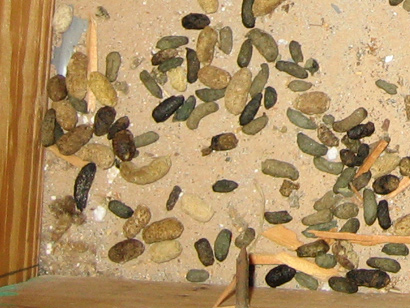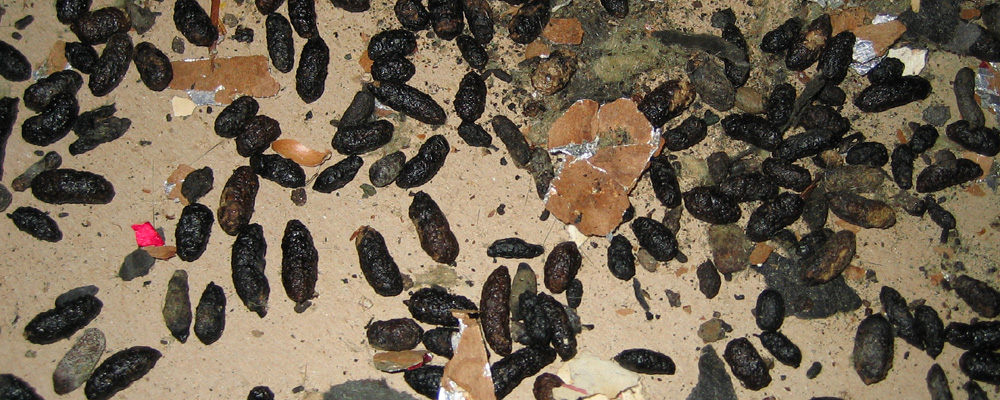- USA Wildlife Removal Education Guide and Resources
Squirrel Feces - Pictures, Danger, and Diseases

Squirrel Feces - Everyone who has ever dealt with a
squirrel infestation in an attic or wall cavity will be very
familiar with squirrel feces, and the range of different
problems that can be caused by this small and relatively
innocuous looking substance. There are a range of different
diseases and conditions that squirrels are known to carry, and
many of the most dangerous diseases that are present in the
squirrel population are transmitted through feces and urine. If
you are preparing to deal with a squirrel infestation, or you
are planning to go up into an attic because you think there may
be squirrels present, it is important to plan appropriately to
make sure you are ready to deal with the feces.
Because of the conditions that can be transmitted by squirrels, particularly those zoonotic diseases that can be passed from squirrel to human, it is important that you take the right precautions before you start to identify and deal with a squirrel infestation. The feces can carry spores and bacteria that can become airborne when it is disturbed, so it is wise to wear a pair of goggles over your eyes and a mask to ensure that you don't inhale any of these. Because touching the feces is also dangerous, you will want to wear a good pair of gloves, and long sleeved clothing or a set of overalls to prevent any accidental contact.
What Does Squirrel Feces Look Like?
This is a very important question as the feces of the squirrel is one of the main factors that you can use to tell the difference between a rat infestation and a squirrel infestation, along with the fact that squirrels tend to be more active during the day. In terms of color, you will usually find that squirrel feces will be a light brown, rusty or reddish color, while rat feces is generally darker brown or even black. It is also important to take note of the shape of the feces, as the diet of the two animals is quite different, and you will find that the pellets of squirrel feces are usually slightly thicker in the middle with rounded edges, while the rat droppings are narrower and tend to have a more pointed end.

Diseases Transmitted By Squirrel Feces
There are a number of diseases that can be transmitted through the feces of squirrels in the same way that it is transmitted by other rodents, which is why it is very important to be careful when dealing with the material. The biggest concern is the presence of leptospirosis in the feces, which is a bacterial condition that is spread through the feces and urine of rodents, and while it can be fairly mild in many cases, causing flu-like symptoms, in other situations it can lead to serious respiratory problems or even death. Salmonella is another condition that you can catch easily from squirrel feces, and this will usually cause symptoms such as diarrhea and vomiting, but is rarely fatal.
Cleaning And Disposing Of The Feces
If you have had the misfortune of finding a squirrel infestation in a wall cavity or an attic space, it is very important that you clean the area thoroughly, as the feces will leave a scent that is sensed by other animals and may draw them into the space. Because of the volume of feces found in the attic, you will usually need to use a vacuum to pick up much of the feces, with a filter vacuum with strong suction best for this kind of work. In many cases, it may have stuck on to a hard surface, so using a chisel knife can help you to get these off too.
Try to avoid any contamination of other parts of the home as you remove the feces, and once outside this can either be disposed of with the trash, or it can be buried well away from your property.
Disinfecting The Area And Repairing Soiled Material
In situations where the insulation in the attic has been soiled by squirrel feces and urine, it will often be almost impossible to get all of the feces out, and if left in place the pheromones can actually attract more squirrels. This is why you should look to replace the insulation, and also make sure that any entry points into the attic are firmly sealed, otherwise the hard work that you have carried out to get rid of the insulation may be required again when more squirrels move in. Once the insulation has been repaired and you have cleaned as much of the feces as possible, it is best to use a disinfectant spray throughout the attic to kill any remaining bacteria so that the area is safe for people to enter again.
Go back to the main Squirrel Removal page for more information about squirrel droppings, feces, or poop. Are the squirrel feces toxic or dangerous? What kind of diseases can you catch from squirrel droppings or excrement.
Read more articles I wrote about squirrels based on my years of professional experience. I can let you know some humane ways to kill a squirrel in a cage and how to find and remove a dead squirrel in a house. Read my advice on how to keep squirrels out of your House and what to do if you find a nest of squirrels in the attic. Learn how well squirrels can climb and jump and if the city or county animal services will help with a squirrel issue. Find out, too, if your homeowners insurance will pay for squirrel damage and the signs to let you know if if you have a Squirrel In Your Attic. Read if it is safe to handle a squirrel with bare hands and how to keep squirrels out of your garden.
Learn how to use a one-way funnel to get squirrels out of a building, and all about a squirrel's natural diet. Read whether or not you should feed a baby squirrel you found and if a squirrel's feces are dangerous to touch or breathe. Find out what diseases squirrels carry and how to clean squirrel feces out of your attic.

